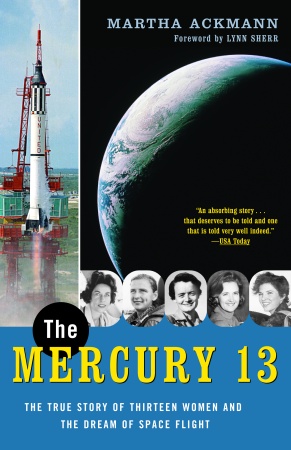






Book Review: The Mercury 13
By Craig E. Ward
The response of the United States to the cold war shock of Sputnik was to mount an aggressive campaign to put Americans into space. The first US effort was with Project Mercury, the program to put a piloted spacecraft into orbit. Just about everyone either remembers or has heard about the Mercury 7, the first seven astronauts chosen to blaze the trail into space. What few know about is that these seven astronauts were not the only possible choices.
 |
| Softcover edition of The Mercury 13, by Martha Ackmann. |
The Mercury 7 were all pilots with military jet and test pilot experience. It is easy to assume that the military was the only pool of talent that NASA could have tapped for candidate astronauts. The book, The Mercury 13 by Martha Ackmann shatters this assumption by retelling the story of the women, and men, with greater vision and the skills, stamina, and courage to go toe-to-toe with the best of the US military pilots.
The process of selecting astronauts in the late 1950s included a series of rigorous physical and mental exams. Some of the tests were performed at USAF bases and others at private medical research facilities. Soon after these tests concluded, Air Force Brigadier General Donald Flickinger started thinking about how women would handle the tests and started talking with Dr. W. Randolph Lovelace II, the director of the private medical research laboratory that had participated in the testing. When General Flickinger hit a brick wall with the idea in the Air Force (a sign of things to come), Dr. Lovelace took up the issue.
Jerrie Cobb is a pilot who should be as well known today as Chuck Yeager. In the 1950s and 1960s, she set new altitude and endurance records for civil aviation. Dr. Lovelace contacted her and invited her to come to his laboratory in Albuquerque to undergo the same tests as he had given the astronaut candidates. Cobb's results were as good or better than the seven selected astronauts. Dr. Lovelace published his findings and this helped generate popular interest in a "girl astronaut" program.
Using Cobb's connections within the pilots' community, Dr. Lovelace was able to test a few dozen more women. Twelve more women achieved results required of the Mercury astronauts.
Then the fun really began.
Dr. Lovelace began plans to take these thirteen women to an Air Force facility for the next step in the medial testing. When someone at NASA got wind of this, the Air Force was told that NASA "had no requirement" for a woman astronaut. This caused the cancellation of the testing.
The rest of the story is one of shameful bureaucrats and weak politicians. Although many people supported the idea of putting women into space, the entrenched bureaucracy did not want to touch it. Hearings were held by the House of Representatives, but these did not change the result.
The unwillingness of NASA to include women in the astronaut program left many dissatisfied and angry. One partisan of the effort, Jane Hart, went on to co-found the National Organization for Women.
In the end, Valentina Tereshkova became the first woman in space in 1963. America had to wait until 1983 when Sally Ride became the first American woman in space. But the Mercury 13 did not feel fully satisfied until 1998 when Eileen Collins became the first woman to pilot a spacecraft.
If the book has a weakness, it is that it overplays the narrow mindedness of men and underplays the role of women in preventing the participation of women in Mercury. It is easy to play Monday morning quarterback and think ill of then Vice President Lyndon Johnson for not helping out. If Johnson is guilty, should not Jacqueline Cochran (a contemporary of Amelia Earhart and surely a pilot in the same caliber as Yeager) also be guilty for not standing up for the Mercury 13? People are creatures of their times. We must be careful not to think ourselves better than they. If we act differently, it is because of the lessons their examples teach us.
You can visit the Mercury 13 online at http://www.mercury13.com/.
Copyright © 1998-2005 Organization for the Advancement of Space Industrialization and Settlement. All Rights Reserved.